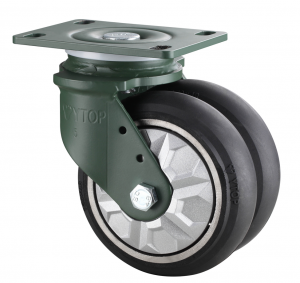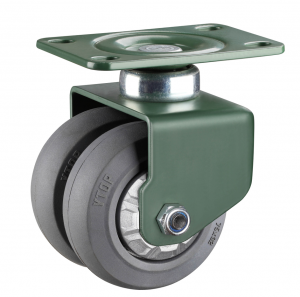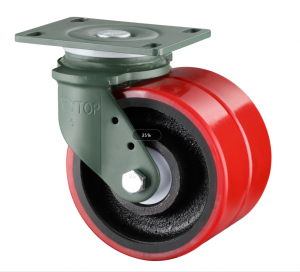in the field of automated logistics.AGVs (Automated Guided Vehicles) play a crucial role.They are equipped with different guidance technologies and control systems.Realizes the automation and intelligence of material handling.While AGV trolleys are able to fulfill various handling tasks flexibly and efficiently.It can’t be separated from the support and drive of its bottom wheels.This article will analyze in detail several main types of AGV trolley wheels.
I. Single rudder wheel type
Single rudder wheel type AGVs are mostly three-wheeled.It is characterized by the installation of an articulated steering wheel as a drive wheel at the front of the AGV.With two rear driven wheels.The advantages of this type of structure are its simplicity and low cost.And because of the single-wheel drive, the No need to consider motor fit issues.The three-wheeled structure grips the ground well and General requirements for ground surfaces.It is therefore suitable for a wide range of environments and situations.However.its relative inflexibility.Turning radius exists for steering.The actions that can be realized are relatively simple.This type of drive is mainly suitable for traction AGVs and forklift AGVs.Performs well in large tonnage cargo handling scenarios.
II. Double rudder wheel type
Dual rudder wheel type AGVs are omnidirectional AGVs.The body is fitted with a rudder wheel at the front and rear.With left and right side driven wheels.This structure allows for 360° swivel function and universal traverse.Flexibility and precise running accuracy.However.The higher cost of two sets of rudder wheels, the And AGV operation often requires two rudder wheels to move differently.This places high demands on the motion control algorithm of the motor.In addition.As a result of four or more wheel configurations, the can easily cause a wheel to overhang and affect operation.Hence the stringent requirements for floor leveling.Dual rudder wheel type AGVs are suitable for heavy-duty latent AGVs or parking robots.It performs well in scenes such as car manufacturing plants and parking lots.
III. Differential wheel type
The structure of differential wheel type AGV is to install differential wheels as driving wheels on the left and right sides of the vehicle body.The others are follower wheels.Unlike the twin rudder wheel type, the The differential wheel is not equipped with a steering motor that Instead, steering is achieved solely by the speed difference between the inner and outer drive wheels.The advantages of this type of drive are the flexibility Also capable of 360° rotation, the But since the differential wheels themselves are not steerable, the So it’s not possible to do a universal traverse.Differential wheel type AGVs are suitable for e-commerce, retail and other warehouse scenarios where the environment is better.For example, the Amazon KIVA robot uses this type of drive.
IV. McNamee wheel type
The McNamee Wheel is a novel design for all-around mobility that It is based on the principle of installing diagonal rollers on a hub that Move or rotate through synergistic movements.These wheels have a load capacity of more than 10 tons, the High flexibility.360° rotary function and universal traverse can be realized.It is more suitable for movement in high precision requirements and limited space.However.its relatively high cost.relatively complex structural forms.There are also higher requirements for controls, fabrication, ground, etc.McNamee wheeled AGVs are suitable for manufacturing scenarios such as aircraft and high-speed rail as well as outdoor robot transportation scenarios.
In summary.There are various types of AGV trolley wheels.Each type has its unique characteristics and applicable scenarios.When selecting an AGV, the Need to choose the right type of wheel according to the actual needs and characteristics of the scene, the To ensure that the AGV can complete the handling tasks efficiently and stably.
Post time: Mar-13-2025



